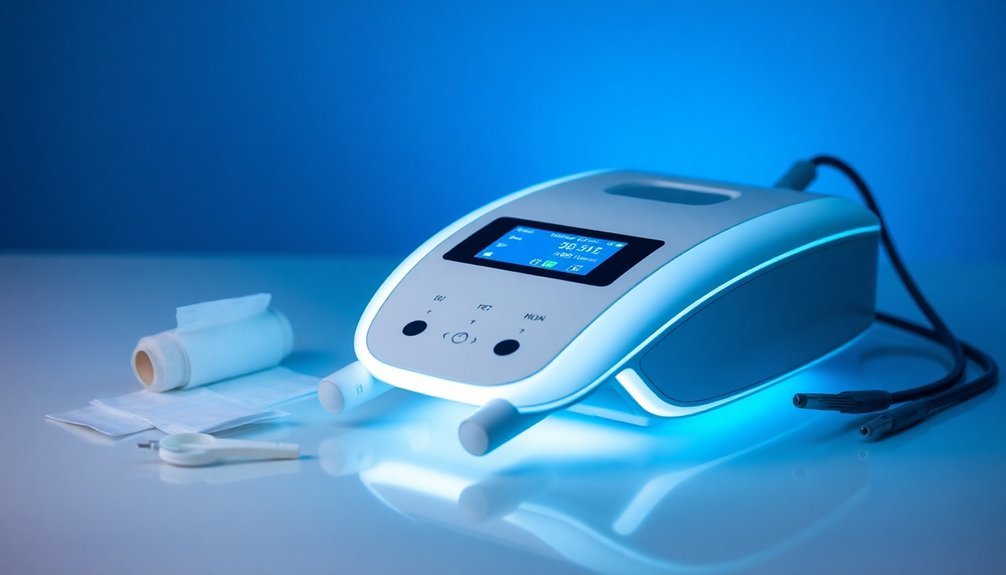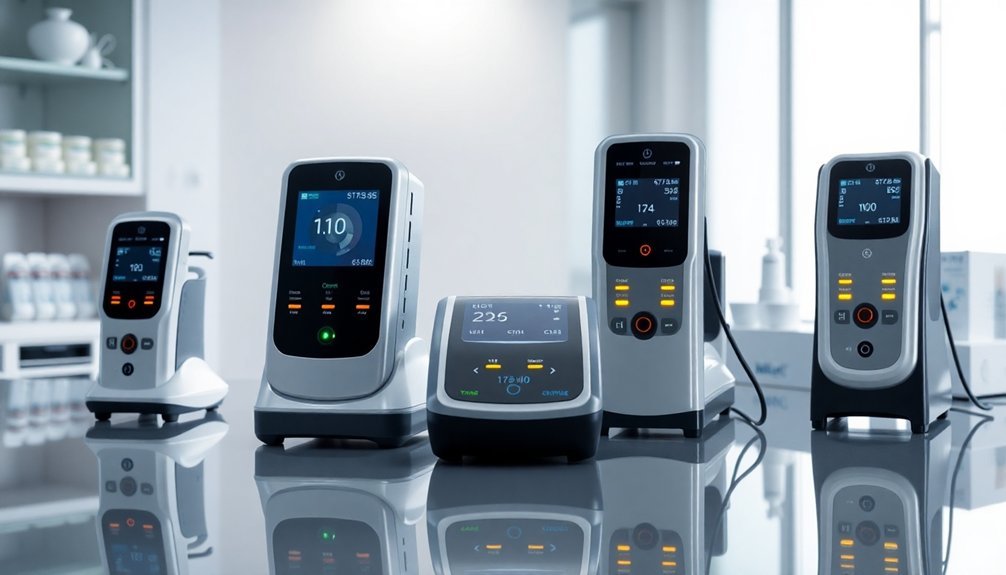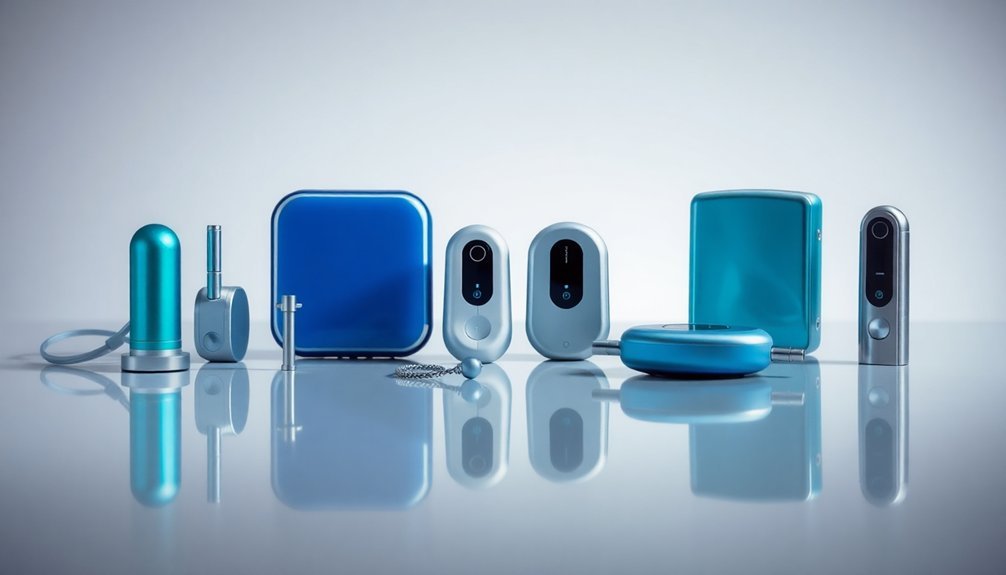When you're looking for the best diabetic wound therapy devices, consider the Smart Negative Pressure (SNaP®) System, Vacuum-Assisted Closure (VAC®) Therapy, and Moist Wound Care (MWC). The SNaP® is ultraportable and adapts well to your wound environment. VAC® offers rapid healing and reduces pain considerably. MWC accelerates healing rates and minimizes infection risks compared to traditional dry dressings. All three methods can effectively address diabetic wounds, customizing your care needs. Each device has unique benefits, so if you want to explore the specifics of these therapies, there's plenty more to discover!
Smart Negative Pressure (SNaP®) System

When managing chronic lower extremity wounds, many healthcare providers turn to the Smart Negative Pressure (SNaP®) Wound Care System for its ultraportable design and ease of use. This mechanically powered device offers a non-electric alternative to traditional NPWT systems, making it ideal for enhancing patient mobility while delivering effective wound care.
Clinical studies reveal that SNaP® matches the wound healing rates of traditional electric NPWT systems like VAC® Therapy, with no significant differences noted in wound size reduction throughout the treatment period. A randomized-controlled trial showed a p-value of <0.05, confirming SNaP®'s noninferiority to VAC® after four weeks of therapy.
Its operational features make SNaP® particularly appealing; it's quieter, compact, and adapts to the wound environment, ensuring consistent negative pressure therapy. The application process is straightforward, increasing patient comfort and compliance. Moreover, the device's design supports the creation of an ideal wound-healing environment, which is critical for promoting granulation tissue formation and improving local blood flow.
However, the SNaP® system should be part of a thorough wound care program that includes regular assessments of wound dimensions and characteristics by a licensed healthcare professional.
Always remember to document progression in wound healing to meet medical necessity criteria for continued use.
Vacuum-Assisted Closure (VAC®) Therapy
Vacuum-Assisted Closure (VAC®) Therapy is a highly effective treatment for chronic wounds, utilizing negative pressure to enhance healing and promote tissue regeneration. This therapy notably increases complete wound healing rates compared to conventional dressings, with an average healing time of just 22.52 days.
By applying controlled negative pressure, VAC therapy encourages rapid granulation tissue formation, effectively reducing ulcer areas faster than traditional methods. The process starts with a sealed dressing placed over the wound. An electronic pump creates a gentle vacuum, promoting a moist wound environment while enhancing blood flow and reducing edema. As the wound bed prepares for closure, fluid is drawn away, supporting quicker recovery.
You'll also find that VAC therapy leads to less pain, with no notable increases in infection or bleeding risks. It's suitable for various wound types, including post-debridement wounds and heel ulcers. Additionally, it's highly cost-effective due to shorter treatment durations, making it a valuable option across all care settings. With VAC therapy, you'll experience quicker healing and improved outcomes tailored to your specific needs. Notably, NPWT has been shown to achieve complete ulcer closure in 43.2% of cases, enhancing its reputation as a leading treatment choice for diabetic foot ulcers.
Moist Wound Care (MWC)

Moist Wound Care (MWC) has emerged as a leading method for promoting wound healing, offering notable advantages over traditional dry dressing techniques. One of the most significant benefits is faster healing, with MWC often leading to accelerated recovery rates.
Studies show that moist dressings provide a lower infection rate at the wound site, and they require fewer dressing changes, minimizing disruption to your routine. Not only do moist dressings reduce overall treatment costs, but they also create an ideal healing environment.
Maintaining moisture prevents dehydration, enhances cellular activities, and promotes critical processes like angiogenesis and collagen synthesis. This approach promotes organized healing and helps minimize scarring. Additionally, MWC complements other treatments, such as negative-pressure wound therapy, by creating a synergistic healing environment.
When you compare MWC to traditional gauze dressings, it clearly outperforms in healing time, infection rates, and ease of care. While MWC shows comparable results to Negative Pressure Wound Therapy (NPWT) in certain scenarios, its robust benefits make it effective for various wound types, especially diabetic foot ulcers.
Whether you're managing a wound related to peripheral neuropathy or arterial disease, MWC can be an effective and economical choice for your healing journey.
Frequently Asked Questions
How Do I Choose the Right Wound Therapy Device for My Patient?
To choose the right wound therapy device for your patient, assess the wound type and size, evaluate infection presence, and consider patient mobility. Monitor progress regularly and confirm compatibility with their overall treatment plan for ideal outcomes.
Are There Any Contraindications for Using NPWT Devices?
Yes, there are contraindications for using NPWT devices. You should avoid them if there's exposed crucial structures, malignant tissue, untreated infections, necrotic tissue, delicate skin, or active bleeding, as these can worsen the patient's condition.
What Is the Cost Difference Between NPWT and MWC Treatments?
The cost difference between NPWT and conventional moist wound care treatments shows NPWT is often more economical over time, with lower daily treatment costs and reduced hospital stays, despite higher initial expenses. You'll save overall.
How Often Should I Change the Dressing With NPWT Systems?
You'll typically change the NPWT dressing every 48 to 72 hours, but if your wound has heavy drainage or infection, you might need to change it every 12 to 24 hours for effective healing.
Can NPWT Be Used With Infected Wounds?
Yes, you can use NPWT with infected wounds. It accelerates healing, reduces hospital stays, and promotes granulation tissue formation, making it effective. Just guarantee correct application and regular monitoring to minimize potential adverse events.
In Summary
In conclusion, choosing the right wound therapy device is essential for effective diabetic wound care. The Smart Negative Pressure (SNaP®) System offers portability and ease of use, while Vacuum-Assisted Closure (VAC®) Therapy delivers proven results for challenging wounds. If you prefer a simpler method, Moist Wound Care (MWC) provides a less invasive option. Consider your specific needs and consult with your healthcare provider to find the best fit for your treatment journey.





Leave a Reply